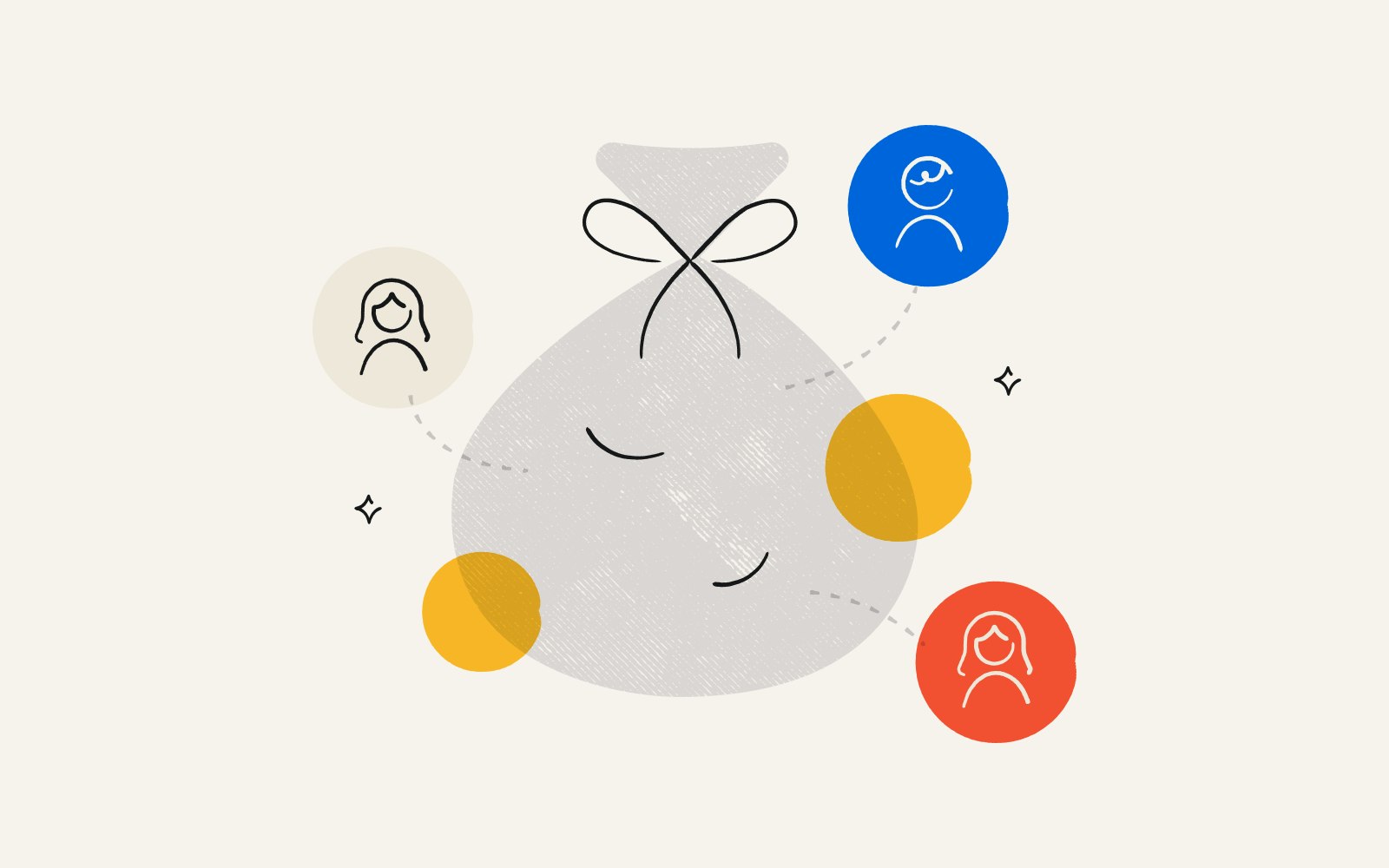Understanding employee bonuses, types, and implications
By Zach Links●5 min. read●Jan 9, 2025

Remote work, changing employee expectations, and competition for top talent have shaped how companies approach compensation and rewards today. That’s why smart organizations are taking a fresh look at bonuses and incentives to boost retention and engagement.
Consider this: employee turnover costs companies up to 2x an employee's salary when accounting for lost productivity and institutional knowledge. And research also shows that companies with well-designed recognition programs see 31% lower voluntary turnover rates.
Performance-based incentives are especially powerful for driving innovation and growth. A 2022 study found that quality incentives significantly increased innovation at small and mid-sized companies.
The right bonus structure can also increase employee engagement by up to 40%, even when base salaries are below market rate. This makes bonuses a cost-effective tool for keeping top performers happy.
In short, bonus programs help create a culture of recognition while giving employees tangible rewards for their contributions.
Yet, many companies struggle to implement effective bonus programs that align with their organizational goals and employee needs. Understanding the different types of bonuses and how to implement them effectively is crucial for HR leaders looking to attract and retain top talent.
What are employee bonuses?
Employee bonuses are additional compensation beyond regular salary or wages. These rewards can be tied to individual performance, team milestones, or company results.
Bonuses serve multiple purposes in a comprehensive compensation strategy. They incentivize desired employee behaviors and outcomes while providing flexibility in total compensation as business conditions change.
Impactful bonus programs align individual incentives with company objectives. Your rewards should be meaningful enough to drive behavior while remaining financially sustainable for the business.
Clear metrics and timelines help employees understand exactly what they're working toward. This transparency builds trust and increases your bonus program's impact on performance.
Types of employee bonuses
Most bonus programs fall into two categories: discretionary and non-discretionary.
Discretionary bonuses give employers the flexibility to reward performance as they see fit, without predefined criteria or guarantees.
Non-discretionary bonuses are tied to specific metrics, milestones, or periods. These structured programs create clear expectations by defining what employees must achieve to earn their bonus.
Even when a bonus is guaranteed, the amount given may vary based on individual, department, or company performance.
Here's a look at the most common types of employee bonuses, their typical structures, and how HR pros use them in their compensation strategies.
Performance-based bonuses
Performance bonuses reward employees for meeting or exceeding specific goals. These incentives typically range from 5 to 20% of base salary, depending on role and seniority level.
A recent study from Salimi and della Torre found that group bonuses tend to drive collective activities like knowledge-sharing and complex teamwork. However, highly skilled and knowledgeable employees prefer incentives that reward their individual performance.
Referral bonuses
Referral programs incentivize employees to recommend qualified candidates for open roles. Bonus amounts can vary by industry, job function, and role seniority.
As an extreme example, ThoughtSpot, a Bay Area business data startup, offers an enticing $20,000 referral bonus to land top-tier engineers. More typically, large tech companies offer around $3,000 per successful hire.
Referral bonuses drive retention across all industries, regardless of bonus size. A 2013 study found that referred workers have lower turnover in tech (23%), as well as in trucking (11%) and customer service (13%), where bonuses range from $50 to $500.
Signing bonuses
Signing (or sign-on) bonuses help attract top talent in competitive markets. These one-time payments — usually 5 to 20% of base salary — can offset transition costs and incentivize candidates to choose your company.
Most companies protect their investment with clawback provisions. About 63% of signing bonuses include clauses requiring repayment if employees leave within their first year, according to a recent WorldatWork survey.
Payment structures vary by company. Some organizations distribute the full bonus immediately, while others spread it across multiple installments to encourage employees to stay.
Holiday bonuses
Holiday bonuses show your company’s appreciation and can help employees with year-end expenses. Companies may provide holiday bonuses as fixed amounts or a percentage of salary.
Consistent holiday bonuses can help employees plan their finances while building goodwill — but putting all your eggs into the Q4 basket may not be the most effective option.
Small, frequent bonuses have been shown to boost employee motivation and effort more than one large annual payout. When it comes to the holidays, a small reward of $50 to $200 can go a long way when paired with other bonuses throughout the year.
Spot bonuses
Spot bonuses provide immediate recognition for exceptional work. Spot bonuses given as gift cards or monetary transfers can range from $50 to $1,000+, depending on your company’s size and the reason for the reward.
The immediacy of spot bonuses makes them particularly effective for reinforcing desired behaviors. They show that exceptional effort gets noticed and rewarded promptly.
Companies like Google have seen positive results with experience-based rewards like high-end dinners and international travel. Our recent study found that 65% of employees prefer the flexibility of monetary rewards over experiences or physical gifts.
Profit-sharing
Profit-sharing programs distribute a portion of your company’s earnings to employees. This aligns employee interests with company success, providing variable compensation clearly tied to business performance.
Companies often use the comp-to-comp approach, where profit-sharing contributions are proportional to employee salaries. These shared profits can create a sense of ownership and encourage long-term commitment from employees.
Profit-sharing plans usually include restrictions on when and how employees can withdraw their funds without penalties. Employers must follow IRS guidelines to ensure their programs don't unfairly favor highly compensated employees.
Tax implications of employee bonuses
Bonuses are typically subject to higher withholding rates than regular wages. The IRS generally requires 22% federal withholding on supplemental wages under $1 million.
This federal tax applies to both cash bonuses and cash equivalent rewards like gift cards or prepaid cards. If your company sends gift cards to full-time employees, you’ll need to include the amount in your employees’ W-2s and income tax withholdings.
Tax implications vary state-by-state. Some states apply special withholding rates to bonuses, while others treat them as regular income.
Your organization should clearly communicate the tax implications of your bonuses to employees as part of your program. This will prevent surprises and ensure employees understand their actual take-home amount.
Considerations when building an employee bonus program
A well-designed bonus program can significantly boost employee engagement and retention. Before launching your program, your HR team will want to evaluate several key factors to ensure it delivers value for both your organization and your employees.
Organizational goals
Your bonus structure should align with your company’s strategic objectives. Define clear metrics that support growth while remaining achievable for employees.
Program design impacts employee behavior and results. Research shows that overly complex programs can hinder performance, so in most cases, it’s best to keep things simple.
Employee preferences
Individual employees are motivated by different incentives. If you’re not sure what your team will respond to, survey your workforce to gather information on their bonus preferences. Some people may value immediate, smaller rewards, while others might prefer longer-term, larger incentives.
No matter what bonus structure you choose, employees expect transparency in compensation practices. Clear communication about bonus criteria and timing will build trust and incentivize strong performance.
Budget and financial variability
Set sustainable bonus targets that work in both strong and challenging business conditions. Review and adjust your bonus structures annually as business conditions evolve.
The Society for Human Resource Management (SHRM) recommends budgeting at least 1% of total payroll to employee rewards. Some organizations allocate up to ~10% of payroll, depending on company health and program performance.
Fairness and inclusivity
Develop objective criteria for bonus eligibility and amounts. Ensure equal opportunity for employees to earn bonuses across departments and demographics.
Regular audits can help you identify and address any unintended biases in your bonus program requirements. Include clear appeals processes for merit-based bonus decisions.
How to start an employee bonus program
Before you roll out a bonus program for the first time, it’s important to define clear objectives and success metrics. Define what behaviors and outcomes you want to incentivize and how you’ll measure these outcomes.
Create detailed policies covering eligibility and payment timing. Clear documentation can prevent misunderstandings and ensure consistent application across teams and roles.
Choose a reliable platform for bonus distribution. An employee rewards and recognition platform can simplify payment delivery while providing detailed tracking and reporting for your HR and finance teams.
Before a full rollout, test your program with a pilot group of employees. Once your program is in flight, continue to revisit your program goals and gather feedback from employees and managers to maximize your ROI.
Employee bonuses can be a powerful tool to drive engagement and retention in today's competitive talent landscape. The right program structure combined with clear guidelines and communication can significantly impact your organization's success. Start small, measure your results, and adjust your bonus approach based on data to build a sustainable program that benefits your employees and your company.

